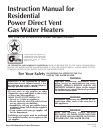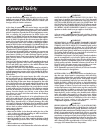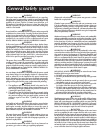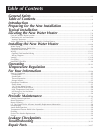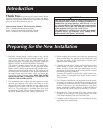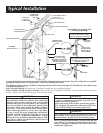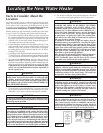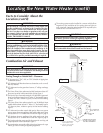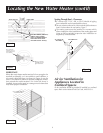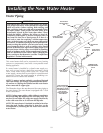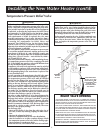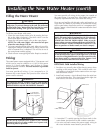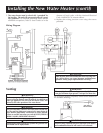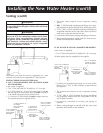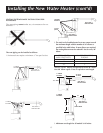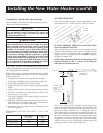
General Safety
2
WARNING
WATER HEATERS EQUIPPED FOR ONE TYPE GAS ONLY: This
water heater is equipped for one type gas only. Check the model
rating plate near the gas control valve for the correct gas. DO NOT
USE THIS WATER HEATER WITH ANY GAS OTHER THAN THE
ONE SHOWN ON THE MODEL RATING PLATE. Failure to use the
correct gas can cause problems which can result in DEATH, SERI-
OUS BODILY INJURY, OR PROPERTY DAMAGE. If you have any
questions or doubts consult your gas supplier or local utility.
WARNING
A fire can start if combustible materials such as clothing, cleaning
materials, or flammable liquids are placed against or next to the
water heater.
WARNING
INSTALLATIONS IN AREAS WHERE FLAMMABLE LIQUIDS
(VAPORS) ARE LIKELY TO BE PRESENT OR STORED (GARAGES,
STORAGE, AND UTILITY AREAS, ETC): Flammable liquids (such as
gasoline, solvents, propane (LP) or butane, etc.), all of which emit
flammable vapors, may be improperly stored or used in such areas.
The gas water heater ignitor or main burner can ignite such vapors.
The resulting flashback and fire can cause death or serious burns to
anyone in the area, as well as property damage.
If installation in such areas is your only option, then the installation
must be accomplished in a way that the ignitor and main burner
flame are elevated from the floor at least 18 inches. While this may
reduce the chances of flammable vapors from a floor spill being
ignited, gasoline and other flammable substances should never be
stored or used in the same room or area containing a gas water
heater or other open flame or spark producing appliance.
NOTE: Flammable vapors may be drawn by air currents from other
areas of the structure to the appliance.
WARNING
HOTTER WATER CAN SCALD: Water heaters are intended to pro-
duce hot water. Water heated to a temperature which will satisfy
clothes washing, dish washing, and other sanitizing needs can scald
and permanently injure you upon contact. Some people are more
likely to be permanently injured by hot water than others. These
include the elderly, children, the infirm, or physically/mentally
handicapped. If anyone using hot water in your home fits into one
of these groups or if there is a local code or state law requiring a
certain temperature water at the hot water tap, then you must take
special precautions. In addition to using the lowest possible tem-
perature setting that satisfies your hot water needs, some type of
tempering device, such as a mixing valve, should be used at the hot
water taps used by these people or at the water heater. Mixing
valves are available at plumbing supply or hardware stores. Follow
manufacturers instructions for installation of the valves. Before
changing the factory setting on the thermostat, read the
“Temperature Regulation” section in this manual.
WARNING
BEFORE OPERATING [PROPANE (L.P.) GAS WATER HEATERS]:
Propane (L.P.) gas is heavier than air. Should there be a leak in the
system, the gas will settle near the ground. Basements, crawl spaces,
skirted areas under manufactured (mobile) homes (even when ven-
tilated), closets and areas below ground level will serve as pockets
for the accumulation of this gas. Before attempting to operate the
water heater or turning on a nearby electrical light switch, be abso-
lutely sure there is no accumulated gas in the area. Search for odor
of gas by sniffing at ground level in the vicinity of the appliance. If
odor is detected, follow steps indicated at “For Your Safety” on the
cover page of this manual then leave the premises.
WARNING
Improper installation, adjustment, alteration, service or main-
tenance can cause DEATH, SERIOUS BODILY INJURY, OR
PROPERTY DAMAGE. Refer to this manual or consult your
local gas utility for further assistance.
WARNING
At the time of manufacture this water heater was provided
with a combination temperature-pressure relief valve certified
by a nationally recognized testing laboratory that maintains
periodic inspection of production of listed equipment or mate-
rials, as meeting the requirements for Relief Valves and
Automatic Gas Shutoff Devices for Hot Water Supply Systems,
and the current edition of ANSI Z21.22 and the code require-
ments of ASME. If replaced, the valve must meet the require-
ments of local codes, but not less than a combination temper-
ature and pressure relief valve certified as meeting the require-
ments for Relief Valves and Automatic Gas Shutoff Devices for
Hot Water Supply Systems, ANSI Z21.22 by a nationally rec-
ognized testing laboratory that maintains periodic inspection
of production of listed equipment or materials.
The valve must be marked with a maximum set pressure not
to exceed the marked hydrostatic working pressure of the
water heater (150 lbs. p.s.i.) and a discharge capacity not less
than the water heater input rate as shown on the model rating
plate. (Electric heaters - watts divided by 1000 x 3412 equal
BTU/Hr. rate.)
Your local jurisdictional authority, while mandating the use of
a temperature-pressure relief valve complying with ANSI
Z21.22 and ASME, may require a valve model different from
the one furnished with the water heater.
Compliance with such local requirements must be satisfied by
the installer or end user of the water heater with a locally pre-
scribed temperature-pressure relief valve installed in the des-
ignated opening in the water heater in place of the factory fur-
nished valve.
For safe operation of the water heater, the relief valve must
not be removed from it’s designated opening or plugged.
The temperature-pressure relief valve must be installed direct-
ly into the fitting of the water heater designated for the relief
valve. Position the valve downward and provide tubing so that
any discharge will exit only within 6 inches above, or at any
distance below the structural floor. Be certain that no contact
is made with any live electrical part. The discharge opening
must not be blocked or reduced in size under any circum-
stances. Excessive length, over 30 feet, or use of more than
four elbows can cause restriction and reduce the discharge
capacity of the valve.
No valve or other obstruction is to be placed between the
relief valve and the tank. Do not connect tubing directly to
discharge Drain unless a 6
″″
air gap is provided. To prevent
bodily injury, hazard to life, or property damage, the relief
valve must be allowed to discharge water in quantities should
circumstances demand. If the discharge pipe is not connect-
ed to a drain or other suitable means, the water flow may
cause property damage.
The Discharge Pipe:
—Must not be smaller in size than the outlet pipe size of the
valve, or have any reducing couplings or other restrictions.
—Must not be plugged or blocked.
—Must be of material listed for hot water distribution.
—Must be installed so as to allow complete drainage of both
the temperature-pressure relief valve, and the discharge
pipe.
—Must terminate at an adequate drain.
—Must not have any valve between the relief valve and tank.



